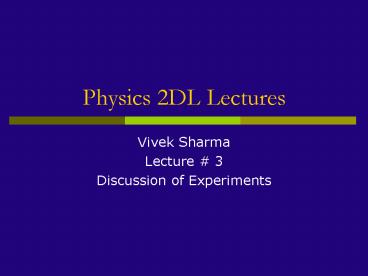Physics 2DL Lectures PowerPoint PPT Presentation
1 / 18
Title: Physics 2DL Lectures
1
Physics 2DL Lectures
- Vivek Sharma
- Lecture 3
- Discussion of Experiments
2
Franck-Hertz Experiment A prelude
- Bohr Atom Discrete orbit ? Emission
Absorption line
3
Franck Hertz Experiment Playing Football !
Inelastic scattering of electrons Confirms Bohrs
Energy quantization Electrons ejected from
heated cathode At zero potential are drawn
towards the positive grid G. Those passing
thru Hole in grid can reach plate P and
cause Current in circuit if they have
sufficient Kinetic energy to overcome the
retarding Potential between G and P Tube
contains low pressure gas of stuff! If incoming
electron does not have enough energy to transfer
??E2-E1 then Elastic scattering, if electron has
atleast KE ?? then inelastic scattering and the
electron does not make it to the plate P ? Loss
of current
4
(J) Franck (G) Hertz Experiment
Current decreases because many Electrons lose
energy due to inelastic Scattering with the Hg
atom in tube And therefore can not overcome
the Small retarding potential between G ? P The
regular spacing of the peaks Indicates that ONLY
a certain quantity Of energy can be lost to the
Hg atoms ??4.9 eV. This interpretation can be
confirmed by Observation of radiation of photon
energy Ehf4.9 eV emitted by Hg atom when V0
gt 4.9V
5
Atomic Spectra
6
Propagation of Plane Wave in Vacuum Huygens
- Huygens theory of Wave propagation allows us to
tell the future location of wave front - All points on a wave front serve as a point
source of spherical secondary wavelet. After a
time t, the new position of wavefront will be
that of a surface tangent to these secondary
wavelets
Coherence of Light if 2 light waves meet at a
point are to interfere perceptibly, then the
phase difference between them must remain
constant with time that is waves must be
coherent. Degree of coherence of a source of
light is the degree to which light consists of
long, unbroken trains (packets) of Sinusoidal
waves Coherent Sources Laser, radiating atom
(but they all have a spread of wavelengths) Incohe
rent Source Light bulb
7
Diffraction Phenomenon
If a wave encounters a barrier that has an
opening of dimensions similar to the ?, the part
of the wave that passes thru opening will spread
out (diffract) into a region beyond the barrier
(spreading of Huygens wavelets)
Narrower the slit, larger the diffraction Diffrac
tion limits geometrical optics (ray tracing)
8
Youngs Double Slit Interference Experiment
Condition for constructive Interference
Overlapping waves must have same phase So the
path lengths traversed by the two waves must
satisfy ?L d sin? m l (m0,1,2,3..) Destructi
ve Inter. at the screen when 2 waves exactly out
of phase d sin? (m1/2) l (m0,1,2,..) With
this simple idea , Young could measure the
average wavelength of the sun (555nm) !
9
Michelsons Interferometer
- Interferometer device to measure lengths or
changes in lengths with great accuracy by means
of interference fringes (big daddy of them all
was designed by Michelson in 1881first American
Nobel prize 1907) - How it works
- Light from source at P encounters beam splitter
- Beam splitter transmits ½ and reflects ½ of
incident - The 2 waves now head towards M1 and M2 mirrors
- Get reflected entirely and sent back along
direction of incidence and then deflected towards
telescope T - Observer at T sees a pattern of zebra strip
like fringes
Path length D when 2 waves combine at
telescope2d2 2d1 anything that changes this
path diff D will cause change in phase diff
between two waves at the eye. E.g. If mirror M1
moves by l/2 then D changes by l and fringe
pattern shifted by 1 (max? min)
10
Single Slit Diffraction
Condition for First Minimum (a/2) sin?
l/2
11
Diffraction Grating Mechanism Intensity
Distribution
Similar to double-slit except many more slits
(ruling) 1000 Monochromatic light thru grating
forms narrow interference Fringes(lines) that can
be analyzed to determine l of light If d
grating spacing, show that d Sin??m? ( condition
for maxima) Width of
line D? ? / (N d Cos ?)
12
A Grating Spectrograph
13
NaCl X-ray Diffractio Orientation Important!
nl2dsin??
14
Bragg Scattering of X-Ray Light
15
Electron Diffraction Davisson Germer Expt
16
Electron Diffraction Davisson Germer Expt
17
Diffraction Pattern in Polycrystalline Al target
Diffraction pattern produced by 600eV electrons
incident on a Al foil target
18
E.Coli Seen With Electron Microscope

